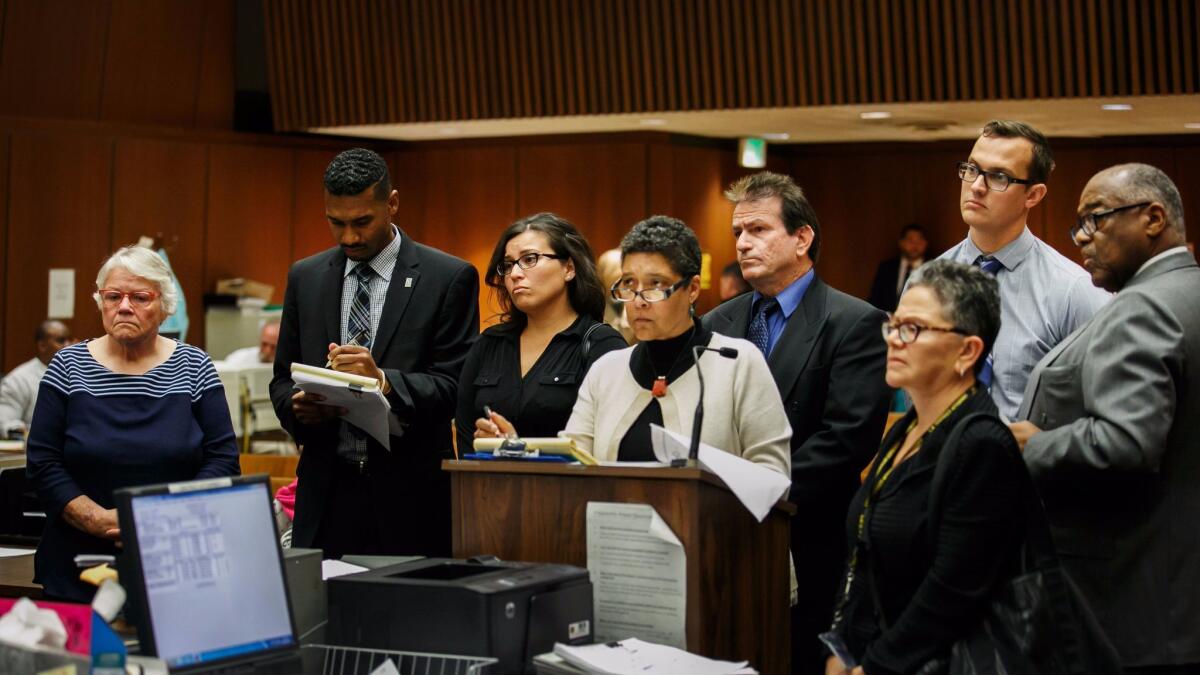Editorial: Charging child welfare workers was the wrong response to failures in the Gabriel Fernandez case

- Share via
A Los Angeles Superior Court judge on Thursday dismissed criminal charges against four L.A. County employees in the 2013 child abuse death of 8-year-old Gabriel Fernandez, leaving this lingering question: Why on Earth did prosecutors seek to put child welfare workers in prison for up to 10 years for messing up an investigation into allegations of child abuse?
To be sure, the failures were serious. In retrospect, it is easy to imagine a scenario in which social workers Stefanie Rodriguez and Patricia Clement and supervisors Kevin Bom and Gregory Merritt were more observant and diligent and stepped in to stop the murderous and sadistic torture inflicted on Gabriel by his mother and her boyfriend in their Palmdale home.
Gabriel told his teacher that his mother had punched him and shot him in the face with a BB gun. He had burns over most of his body. He had a fractured skull and broken ribs. His wounds were visible.
It’s understandable that the public was angry at the L.A. County Department of Children and Family Services and the four employees for visiting the boy and concluding that there was no reason to remove him from his home, despite escalating pleas for help from people who’d seen the boy’s injuries. Even three years after Gabriel’s death, there was a palpable feeling that someone had to pay dearly for such a failure.
But it must not be forgotten that the actual abuse was inflicted by Gabriel’s mother, Pearl Sinthia Fernandez, who was sentenced to life in prison without parole for first-degree murder, and her boyfriend, Isauro Aguirre, who was sentenced to death for first-degree murder with the special circumstance of murder involving torture.
The child welfare workers may have been incompetent. But they were not, themselves, child abusers, which is the crime they were accused of (along with falsifying records). Criminal charges were an overreach, a fact that had become apparent even before an appeals court ruled earlier this year that prosecutors had failed to show probable cause that the four had committed abuse (one dissenting justice said charges for falsifying documents should have gone forward).
There are parallels and contrasts — imperfect, but in some measure useful — between child welfare workers who fail to protect a child and other public employees who arguably mess up on the job so much that someone dies. Police officers, for example.
A police officer who pulls the trigger without good cause affirmatively causes his victim’s death and should be prosecuted. But the cop who fails to pull the trigger when he should, or fails to stop a crime and in so doing allows someone to die whom he could have saved, is not a criminal. Incompetent, perhaps, and in the wrong job. But not a crook. The social workers and supervisors in Gabriel’s case are like the cop who failed to save the victim. They didn’t kill Gabriel, even if their shortcomings failed to save him.
It’s worth noting that at this moment in history, when angry protesters are calling to defund or even abolish police on the argument that they are part of an inherently racist system that oppresses Black and Latino Americans, some are calling to likewise defund and disband child protective services.
County child welfare departments are indeed police of a sort, possessing the stunning governmental power to take children from their parents even without court orders. Without doubt they remove kids disproportionately from Black and Latino families. For all their good intentions, and the good intentions of a citizenry that demands more aggressive child protection, critics say that child welfare agencies operate from a racially and culturally ignorant perspective that sees poverty as child abuse. Beware calls to defund police in favor of funding social welfare agencies, they argue, when those agencies are also steeped in a racist and harm-causing framework. Their proposed solutions can be too extreme, but their argument is interesting and warrants serious debate.
Cases of actual, intentional parental harm to children are rare — far rarer than the number of children removed from homes for alleged abuse. But as Gabriel’s case makes clear, they do happen. We set up public agencies to find endangered kids and rescue them, and we expect the people who signed up for this work to walk the wavy line that separates racist government intrusion from official neglect with potentially deadly consequences.
We can’t be too surprised when they sometimes fail. The answer is to reconsider what we ask them to do, and how we ask them to do it, and to help them help the children and families they are supposed to serve, not send them to prison if they fall short.
More to Read
A cure for the common opinion
Get thought-provoking perspectives with our weekly newsletter.
You may occasionally receive promotional content from the Los Angeles Times.










